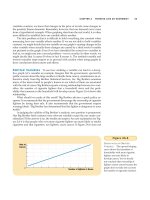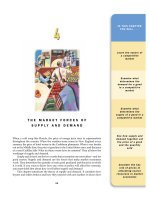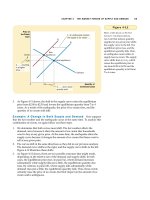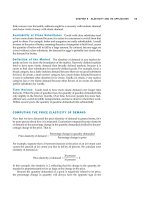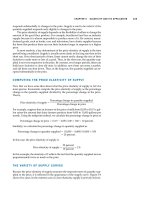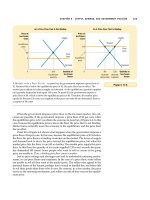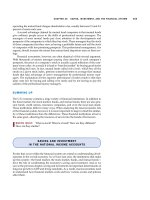Tài liệu Ten Principles of Economics - Part 79 ppt
Bạn đang xem bản rút gọn của tài liệu. Xem và tải ngay bản đầy đủ của tài liệu tại đây (210.54 KB, 10 trang )
CHAPTER 34 FIVE DEBATES OVER MACROECONOMIC POLICY 807
QUICK QUIZ: Give three examples of how our society discourages saving.
What are the drawbacks of eliminating these disincentives?
CONCLUSION
This chapter has considered five debates over macroeconomic policy. For each, it
began with a controversial proposition and then offered the arguments pro and
con. If you find it hard to choose a side in these debates, you may find some com-
fort in the fact that you are not alone. The study of economics does not always
make it easy to choose among alternative policies. Indeed, by clarifying the in-
evitable tradeoffs that policymakers face, it can make the choice more difficult.
Difficult choices, however, have no right to seem easy. When you hear politi-
cians or commentators proposing something that sounds too good to be true, it
probably is. If they sound like they are offering you a free lunch, you should look
for the hidden price tag. Few if any policies come with benefits but no costs. By
helping you see through the fog of rhetoric so common in political discourse, the
study of economics should make you a better participant in our national debates.
◆ Advocates of active monetary and fiscal policy view the
economy as inherently unstable and believe that policy
can manage aggregate demand to offset the inherent
instability. Critics of active monetary and fiscal policy
emphasize that policy affects the economy with a lag
and that our ability to forecast future economic
conditions is poor. As a result, attempts to stabilize the
economy can end up being destabilizing.
◆ Advocates of rules for monetary policy argue that
discretionary policy can suffer from incompetence,
abuse of power, and time inconsistency. Critics of rules
for monetary policy argue that discretionary policy is
more flexible in responding to changing economic
circumstances.
◆ Advocates of a zero-inflation target emphasize that
inflation has many costs and few if any benefits.
Moreover, the cost of eliminating inflation—depressed
output and employment—is only temporary. Even this
cost can be reduced if the central bank announces a
credible plan to reduce inflation, thereby directly
lowering expectations of inflation. Critics of a zero-
inflation target claim that moderate inflation imposes
only small costs on society, whereas the recession
necessary to reduce inflation is quite costly.
◆ Advocates of reducing the government debt argue that
the debt imposes a burden on future generations by
raising their taxes and lowering their incomes. Critics of
reducing the government debt argue that the debt is
only one small piece of fiscal policy. Single-minded
concern about the debt can obscure the many ways in
which the government’s tax and spending decisions
affect different generations.
◆ Advocates of tax incentives for saving point out that our
society discourages saving in many ways, such as by
heavily taxing the income from capital and by reducing
benefits for those who have accumulated wealth. They
endorse reforming the tax laws to encourage saving,
perhaps by switching from an income tax to a
consumption tax. Critics of tax incentives for saving
argue that many proposed changes to stimulate saving
would primarily benefit the wealthy, who do not need a
tax break. They also argue that such changes might have
only a small effect on private saving. Raising public
saving by increasing the government’s budget surplus
would provide a more direct and equitable way to
increase national saving.
Summary
808 PART THIRTEEN FINAL THOUGHTS
1. What causes the lags in the effect of monetary and fiscal
policy on aggregate demand? What are the implications
of these lags for the debate over active versus passive
policy?
2. What might motivate a central banker to cause a
political business cycle? What does the political business
cycle imply for the debate over policy rules?
3. Explain how credibility might affect the cost of reducing
inflation.
4. Why are some economists against a target of zero
inflation?
5. Explain two ways in which a government budget deficit
hurts a future worker.
6. What are two situations in which most economists view
a budget deficit as justifiable?
7. Give an example of how the government might hurt
young generations, even while reducing the
government debt they inherit.
8. Some economists say that the government can continue
running a budget deficit forever. How is that possible?
9. Some income from capital is taxed twice. Explain.
10. Give an example, other than tax policy, of how our
society discourages saving.
11. What adverse effect might be caused by tax incentives
to raise saving?
Questions for Review
1. The chapter suggests that the economy, like the human
body, has “natural restorative powers.”
a. Illustrate the short-run effect of a fall in aggregate
demand using an aggregate-demand/aggregate-
supply diagram. What happens to total output,
income, and employment?
b. If the government does not use stabilization policy,
what happens to the economy over time? Illustrate
on your diagram. Does this adjustment generally
occur in a matter of months or a matter of years?
c. Do you think the “natural restorative powers” of
the economy mean that policymakers should be
passive in response to the business cycle?
2. Policymakers who want to stabilize the economy must
decide how much to change the money supply,
government spending, or taxes. Why is it difficult for
policymakers to choose the appropriate strength of their
actions?
3. Suppose that people suddenly wanted to hold more
money balances.
a. What would be the effect of this change on the
economy if the Federal Reserve followed a rule of
increasing the money supply by 3 percent per year?
Illustrate your answer with a money-market
diagram and an aggregate-demand/aggregate-
supply diagram.
b. What would be the effect of this change on the
economy if the Fed followed a rule of increasing
the money supply by 3 percent per year plus
1 percentage point for every percentage point
that unemployment rises above its normal level?
Illustrate your answer.
c. Which of the foregoing rules better stabilizes
the economy? Would it help to allow the Fed to
respond to predicted unemployment instead of
current unemployment? Explain.
4. Some economists have proposed that the Fed use the
following rule for choosing its target for the federal
funds interest rate (r):
r ϭ 2% ϩ π ϩ 1/2 (y Ϫ y*)/y* ϩ 1/2 (π Ϫ π*),
where π is the average of the inflation rate over the
past year, y is real GDP as recently measured, y* is an
estimate of the natural rate of output, and π* is the Fed’s
goal for inflation.
a. Explain the logic that might lie behind this rule for
setting interest rates. Would you support the Fed’s
use of this rule?
b. Some economists advocate such a rule for monetary
policy but believe π and y should be the forecasts of
future values of inflation and output. What are the
advantages of using forecasts instead of actual
values? What are the disadvantages?
5. The problem of time inconsistency applies to fiscal
policy as well as to monetary policy. Suppose the
Problems and Applications
CHAPTER 34 FIVE DEBATES OVER MACROECONOMIC POLICY 809
government announced a reduction in taxes on income
from capital investments, like new factories.
a. If investors believed that capital taxes would
remain low, how would the government’s action
affect the level of investment?
b. After investors have responded to the announced
tax reduction, does the government have an
incentive to renege on its policy? Explain.
c. Given your answer to part (b), would investors
believe the government’s announcement? What
can the government do to increase the credibility
of announced policy changes?
d. Explain why this situation is similar to the time
inconsistency problem faced by monetary
policymakers.
6. Chapter 2 explains the difference between positive
analysis and normative analysis. In the debate about
whether the central bank should aim for zero inflation,
which areas of disagreement involve positive statements
and which involve normative judgments?
7. Why are the benefits of reducing inflation permanent
and the costs temporary? Why are the costs of
increasing inflation permanent and the benefits
temporary? Use Phillips-curve diagrams in your
answer.
8. Suppose the federal government cuts taxes and
increases spending, raising the budget deficit to
12 percent of GDP. If nominal GDP is rising 7 percent
per year, are such budget deficits sustainable forever?
Explain. If budget deficits of this size are maintained for
20 years, what is likely to happen to your taxes and your
children’s taxes in the future? Can you do something
today to offset this future effect?
9. Explain how each of the following policies redistributes
income across generations. Is the redistribution from
young to old, or from old to young?
a. an increase in the budget deficit
b. more generous subsidies for education loans
c. greater investments in highways and bridges
d. indexation of Social Security benefits to inflation
10. Surveys suggest that most people are opposed to budget
deficits, but these same people elected representatives
who in the 1980s and 1990s passed budgets with
significant deficits. Why might the opposition to budget
deficits be stronger in principle than in practice?
11. The chapter says that budget deficits reduce the income
of future generations, but can boost output and income
during a recession. Explain how both of these
statements can be true.
12. What is the fundamental tradeoff that society faces if it
chooses to save more?
13. Suppose the government reduced the tax rate on income
from savings.
a. Who would benefit from this tax reduction most
directly?
b. What would happen to the capital stock over time?
What would happen to the capital available to each
worker? What would happen to productivity?
What would happen to wages?
c. In light of your answer to part (b), who might
benefit from this tax reduction in the long run?
taxes should be levied on a person
according to how well that person
can shoulder the burden
absolute advantage—the comparison
among producers of a good accord-
ing to their productivity
accounting profit—total revenue mi-
nus total explicit cost
aggregate-demand curve—a curve that
shows the quantity of goods and
services that households, firms, and
the government want to buy at each
price level
aggregate-supply curve—a curve that
shows the quantity of goods and
services that firms choose to pro-
duce and sell at each price level
appreciation—an increase in the value
of a currency as measured by the
amount of foreign currency it can
buy
automatic stabilizers—changes in fis-
cal policy that stimulate aggregate
demand when the economy goes
into a recession without policymak-
ers having to take any deliberate
action
average fixed cost—fixed costs
divided by the quantity of output
average revenue—total revenue
divided by the quantity sold
average tax rate—total taxes paid
divided by total income
average total cost—total cost divided
by the quantity of output
average variable cost—variable costs
divided by the quantity of output
balanced trade—a situation in which
exports equal imports
benefits principle—the idea that peo-
ple should pay taxes based on the
benefits they receive from govern-
ment services
bond—a certificate of indebtedness
budget constraint—the limit on the
consumption bundles that a con-
sumer can afford
budget deficit—a shortfall of tax rev-
enue from government spending
budget surplus—an excess of govern-
ment receipts over government
spending
capital—the equipment and structures
used to produce goods and services
capital flight—a large and sudden
reduction in the demand for assets
located in a country
cartel—a group of firms acting in
unison
catch-up effect—the property whereby
countries that start off poor tend to
grow more rapidly than countries
that start off rich
central bank—an institution designed
to oversee the banking system and
regulate the quantity of money in
the economy
ceteris paribus—a Latin phrase, trans-
lated as “other things being equal,”
used as a reminder that all variables
other than the ones being studied
are assumed to be constant
circular-flow diagram—a visual model
of the economy that shows how dol-
lars flow through markets among
households and firms
classical dichotomy—the theoretical
separation of nominal and real
variables
closed economy—an economy that
does not interact with other
economies in the world
Coase theorem—the proposition that if
private parties can bargain without
cost over the allocation of resources,
they can solve the problem of exter-
nalities on their own
collective bargaining—the process by
which unions and firms agree on
the terms of employment
collusion—an agreement among firms
in a market about quantities to pro-
duce or prices to charge
commodity money—money that takes
the form of a commodity with in-
trinsic value
common resources—goods that are
rival but not excludable
comparable worth—a doctrine accord-
ing to which jobs deemed compara-
ble should be paid the same wage
comparative advantage—the compari-
son among producers of a good ac-
cording to their opportunity cost
compensating differential—a differ-
ence in wages that arises to offset
the nonmonetary characteristics of
different jobs
competitive market—a market with
many buyers and sellers trading
identical products so that each
buyer and seller is a price taker
complements—two goods for which
an increase in the price of one leads
to a decrease in the demand for the
other
constant returns to scale—the prop-
erty whereby long-run average total
cost stays the same as the quantity
of output changes
consumer price index (CPI)—a mea-
sure of the overall cost of the goods
and services bought by a typical
consumer
consumer surplus—a buyer’s willing-
ness to pay minus the amount the
buyer actually pays
consumption—spending by house-
holds on goods and services, with
the exception of purchases of new
housing
cost—the value of everything a seller
must give up to produce a good
cost-benefit analysis—a study that
compares the costs and benefits to
society of providing a public good
cross-price elasticity of demand—a
measure of how much the quantity
demanded of one good responds to
a change in the price of another
good, computed as the percentage
change in quantity demanded of the
first good divided by the percentage
change in the price
crowding out—a decrease in invest-
ment that results from government
borrowing
crowding-out effect—the offset in ag-
gregate demand that results when
expansionary fiscal policy raises the
interest rate and thereby reduces in-
vestment spending
currency—the paper bills and coins in
the hands of the public
cyclical unemployment—the devia-
tion of unemployment from its
natural rate
deadweight loss—the fall in total
surplus that results from a market
distortion, such as a tax
demand curve—a graph of the rela-
tionship between the price of a good
and the quantity demanded
demand deposits—balances in bank
accounts that depositors can access
on demand by writing a check
demand schedule—a table that shows
the relationship between the price
of a good and the quantity
demanded
GLOSSARY
811
depreciation—a decrease in the value
of a currency as measured by the
amount of foreign currency it can
buy
depression—a severe recession
diminishing marginal product—the
property whereby the marginal
product of an input declines as the
quantity of the input increases
diminishing returns—the property
whereby the benefit from an extra
unit of an input declines as the
quantity of the input increases
discount rate—the interest rate on the
loans that the Fed makes to banks
discouraged workers—individuals
who would like to work but have
given up looking for a job
discrimination—the offering of differ-
ent opportunities to similar individ-
uals who differ only by race, ethnic
group, sex, age, or other personal
characteristics
diseconomies of scale—the property
whereby long-run average total
cost rises as the quantity of output
increases
dominant strategy—a strategy that is
best for a player in a game regard-
less of the strategies chosen by the
other players
economic profit—total revenue minus
total cost, including both explicit
and implicit costs
economics—the study of how society
manages its scarce resources
economies of scale—the property
whereby long-run average total
cost falls as the quantity of output
increases
efficiency—the property of society
getting the most it can from its
scarce resources
efficiency wages—above-equilibrium
wages paid by firms in order to in-
crease worker productivity
efficient scale—the quantity of output
that minimizes average total cost
elasticity—a measure of the respon-
siveness of quantity demanded
or quantity supplied to one of its
determinants
equilibrium—a situation in which
supply and demand have been
brought into balance
equilibrium price—the price that bal-
ances supply and demand
equilibrium quantity—the quantity
supplied and the quantity de-
manded when the price has ad-
justed to balance supply and
demand
equity—the property of distributing
economic prosperity fairly among
the members of society
excludability—the property of a good
whereby a person can be prevented
from using it
explicit costs—input costs that re-
quire an outlay of money by the
firm
exports—goods and services that are
produced domestically and sold
abroad
externality—the impact of one per-
son’s actions on the well-being of a
bystander
factors of production—the inputs used
to produce goods and services
Federal Reserve (Fed)—the central
bank of the United States
fiat money—money without intrinsic
value that is used as money because
of government decree
financial intermediaries—financial
institutions through which savers
can indirectly provide funds to
borrowers
financial markets—financial institu-
tions through which savers can di-
rectly provide funds to borrowers
financial system—the group of institu-
tions in the economy that help to
match one person’s saving with
another person’s investment
Fisher effect—the one-for-one adjust-
ment of the nominal interest rate to
the inflation rate
fixed costs—costs that do not vary
with the quantity of output
produced
fractional-reserve banking—a bank-
ing system in which banks hold
only a fraction of deposits as
reserves
free rider—a person who receives the
benefit of a good but avoids paying
for it
frictional unemployment—unemploy-
ment that results because it takes
time for workers to search for the
jobs that best suit their tastes and
skills
game theory—the study of how people
behave in strategic situations
GDP deflator—a measure of the
price level calculated as the ratio
of nominal GDP to real GDP times
100
Giffen good—a good for which an
increase in the price raises the
quantity demanded
government purchases—spending on
goods and services by local, state,
and federal governments
gross domestic product (GDP)—the
market value of all final goods and
services produced within a country
in a given period of time
horizontal equity—the idea that tax-
payers with similar abilities to pay
taxes should pay the same amount
human capital—the accumulation of
investments in people, such as edu-
cation and on-the-job training
implicit costs—input costs that do not
require an outlay of money by the
firm
import quota—a limit on the quantity
of a good that can be produced
abroad and sold domestically
imports—goods and services that
are produced abroad and sold
domestically
in-kind transfers—transfers to the
poor given in the form of goods and
services rather than cash
income effect—the change in con-
sumption that results when a price
change moves the consumer to a
higher or lower indifference curve
income elasticity of demand—a mea-
sure of how much the quantity de-
manded of a good responds to a
change in consumers’ income, com-
puted as the percentage change in
quantity demanded divided by the
percentage change in income
indexation—the automatic correction
of a dollar amount for the effects of
inflation by law or contract
indifference curve—a curve that
shows consumption bundles that
give the consumer the same level of
satisfaction
inferior good—a good for which, other
things equal, an increase in income
leads to a decrease in demand
812 GLOSSARY
inflation—an increase in the overall
level of prices in the economy
inflation rate—the percentage change
in the price index from the preced-
ing period
inflation tax—the revenue the govern-
ment raises by creating money
internalizing an externality—altering
incentives so that people take ac-
count of the external effects of their
actions
investment—spending on capital
equipment, inventories, and struc-
tures, including household pur-
chases of new housing
job search—the process by which
workers find appropriate jobs given
their tastes and skills
labor force—the total number of work-
ers, including both the employed
and the unemployed
labor-force participation rate—the
percentage of the adult population
that is in the labor force
law of demand—the claim that, other
things equal, the quantity de-
manded of a good falls when the
price of the good rises
law of supply—the claim that, other
things equal, the quantity supplied
of a good rises when the price of the
good rises
law of supply and demand—the claim
that the price of any good adjusts to
bring the supply and demand for
that good into balance
liberalism—the political philosophy
according to which the government
should choose policies deemed
to be just, as evaluated by an impar-
tial observer behind a “veil of
ignorance”
libertarianism—the political philoso-
phy according to which the govern-
ment should punish crimes and
enforce voluntary agreements but
not redistribute income
life cycle—the regular pattern of
income variation over a person’s
life
liquidity—the ease with which an
asset can be converted into the
economy’s medium of exchange
lump-sum tax—a tax that is the same
amount for every person
macroeconomics—the study of econ-
omy-wide phenomena, including
inflation, unemployment, and eco-
nomic growth
marginal changes—small incremental
adjustments to a plan of action
marginal cost—the increase in total
cost that arises from an extra unit of
production
marginal product—the increase in out-
put that arises from an additional
unit of input
marginal product of labor—the in-
crease in the amount of output from
an additional unit of labor
marginal rate of substitution—the rate
at which a consumer is willing to
trade one good for another
marginal revenue—the change in total
revenue from an additional unit
sold
marginal tax rate—the extra taxes
paid on an additional dollar of
income
market—a group of buyers and sellers
of a particular good or service
market economy—an economy that
allocates resources through the
decentralized decisions of many
firms and households as they in-
teract in markets for goods and
services
market failure—a situation in which a
market left on its own fails to allo-
cate resources efficiently
market for loanable funds—the mar-
ket in which those who want to
save supply funds and those who
want to borrow to invest demand
funds
market power—the ability of a single
economic actor (or small group of
actors) to have a substantial influ-
ence on market prices
maximin criterion—the claim that the
government should aim to maxi-
mize the well-being of the worst-off
person in society
medium of exchange—an item that
buyers give to sellers when they
want to purchase goods and
services
menu costs—the costs of changing
prices
microeconomics—the study of how
households and firms make deci-
sions and how they interact in
markets
model of aggregate demand and
aggregate supply—the model that
most economists use to explain
short-run fluctuations in economic
activity around its long-run trend
monetary neutrality—the proposition
that changes in the money supply
do not affect real variables
monetary policy—the setting of the
money supply by policymakers in
the central bank
money—the set of assets in an econ-
omy that people regularly use to
buy goods and services from other
people
money multiplier—the amount of
money the banking system gener-
ates with each dollar of reserves
money supply—the quantity of money
available in the economy
monopolistic competition—a market
structure in which many firms sell
products that are similar but not
identical
monopoly—a firm that is the sole
seller of a product without close
substitutes
multiplier effect—the additional shifts
in aggregate demand that result
when expansionary fiscal policy
increases income and thereby in-
creases consumer spending
mutual fund—an institution that sells
shares to the public and uses the
proceeds to buy a portfolio of stocks
and bonds
Nash equilibrium—a situation in
which economic actors interacting
with one another each choose their
best strategy given the strategies
that all the other actors have chosen
national saving (saving)—the total in-
come in the economy that remains
after paying for consumption and
government purchases
natural monopoly—a monopoly that
arises because a single firm can sup-
ply a good or service to an entire
market at a smaller cost than could
two or more firms
natural-rate hypothesis—the claim
that unemployment eventually re-
turns to its normal, or natural, rate,
regardless of the rate of inflation
natural rate of unemployment—the
normal rate of unemployment
around which the unemployment
rate fluctuates
GLOSSARY 813
natural resources—the inputs into the
production of goods and services
that are provided by nature, such as
land, rivers, and mineral deposits
negative income tax—a tax system
that collects revenue from high-
income households and gives trans-
fers to low-income households
net exports—the value of a nation’s ex-
ports minus the value of its imports,
also called the trade balance
net foreign investment—the purchase
of foreign assets by domestic resi-
dents minus the purchase of domes-
tic assets by foreigners
nominal exchange rate—the rate
at which a person can trade the
currency of one country for the cur-
rency of another
nominal GDP—the production of
goods and services valued at cur-
rent prices
nominal interest rate—the interest rate
as usually reported without a cor-
rection for the effects of inflation
nominal variables—variables mea-
sured in monetary units
normal good—a good for which, other
things equal, an increase in income
leads to an increase in demand
normative statements—claims that at-
tempt to prescribe how the world
should be
oligopoly—a market structure in
which only a few sellers offer simi-
lar or identical products
open economy—an economy that in-
teracts freely with other economies
around the world
open-market operations—the pur-
chase and sale of U.S. government
bonds by the Fed
opportunity cost—whatever must be
given up to obtain some item
perfect complements—two goods
with right-angle indifference curves
perfect substitutes—two goods with
straight-line indifference curves
permanent income—a person’s nor-
mal income
Phillips curve—a curve that shows the
short-run tradeoff between inflation
and unemployment
physical capital—the stock of equip-
ment and structures that are used to
produce goods and services
Pigovian tax—a tax enacted to correct
the effects of a negative externality
positive statements—claims that at-
tempt to describe the world as it is
poverty line—an absolute level of in-
come set by the federal government
for each family size below which a
family is deemed to be in poverty
poverty rate—the percentage of the
population whose family income
falls below an absolute level called
the poverty line
price ceiling—a legal maximum on the
price at which a good can be sold
price discrimination—the business
practice of selling the same good
at different prices to different
customers
price elasticity of demand—a mea-
sure of how much the quantity
demanded of a good responds to
a change in the price of that good,
computed as the percentage change
in quantity demanded divided by
the percentage change in price
price elasticity of supply—a measure
of how much the quantity supplied
of a good responds to a change in
the price of that good, computed as
the percentage change in quantity
supplied divided by the percentage
change in price
price floor—a legal minimum on the
price at which a good can be sold
prisoners’ dilemma—a particular
“game” between two captured pris-
oners that illustrates why coopera-
tion is difficult to maintain even
when it is mutually beneficial
private goods—goods that are both
excludable and rival
private saving—the income that
households have left after paying
for taxes and consumption
producer price index—a measure of
the cost of a basket of goods and
services bought by firms
producer surplus—the amount a seller
is paid for a good minus the seller’s
cost
production function—the relationship
between quantity of inputs used to
make a good and the quantity of
output of that good
production possibilities frontier—a
graph that shows the combinations
of output that the economy can pos-
sibly produce given the available
factors of production and the avail-
able production technology
productivity—the amount of goods
and services produced from each
hour of a worker’s time
profit—total revenue minus total cost
progressive tax—a tax for which
high-income taxpayers pay a larger
fraction of their income than do
low-income taxpayers
proportional tax—a tax for which
high-income and low-income tax-
payers pay the same fraction of
income
public goods—goods that are neither
excludable nor rival
public saving—the tax revenue that
the government has left after paying
for its spending
purchasing-power parity—a theory of
exchange rates whereby a unit of
any given currency should be able
to buy the same quantity of goods
in all countries
quantity demanded—the amount of a
good that buyers are willing and
able to purchase
quantity equation—the equation M ϫ
V ϭ P ϫ Y, which relates the quan-
tity of money, the velocity of money,
and the dollar value of the econ-
omy’s output of goods and services
quantity supplied—the amount of a
good that sellers are willing and
able to sell
quantity theory of money—a theory
asserting that the quantity of money
available determines the price level
and that the growth rate in the
quantity of money available deter-
mines the inflation rate
rational expectations—the theory ac-
cording to which people optimally
use all the information they have,
including information about gov-
ernment policies, when forecasting
the future
real exchange rate—the rate at which a
person can trade the goods and
services of one country for the
goods and services of another
real GDP—the production of goods
and services valued at constant
prices
real interest rate—the interest rate
corrected for the effects of inflation
814 GLOSSARY
real variables—variables measured in
physical units
recession—a period of declining real
incomes and rising unemployment
regressive tax—a tax for which high-
income taxpayers pay a smaller
fraction of their income than do
low-income taxpayers
reserve ratio—the fraction of deposits
that banks hold as reserves
reserve requirements—regulations
on the minimum amount of re-
serves that banks must hold against
deposits
reserves—deposits that banks have
received but have not loaned out
rivalry—the property of a good
whereby one person’s use dimin-
ishes other people’s use
sacrifice ratio—the number of percent-
age points of annual output lost in
the process of reducing inflation by
1 percentage point
scarcity—the limited nature of soci-
ety’s resources
shoeleather costs—the resources
wasted when inflation encourages
people to reduce their money
holdings
shortage—a situation in which quan-
tity demanded is greater than
quantity supplied
stagflation—a period of falling output
and rising prices
stock—a claim to partial ownership in
a firm
store of value—an item that people
can use to transfer purchasing
power from the present to the
future
strike—the organized withdrawal of
labor from a firm by a union
structural unemployment—unem-
ployment that results because the
number of jobs available in some
labor markets is insufficient to pro-
vide a job for everyone who wants
one
substitutes—two goods for which an
increase in the price of one leads to
an increase in the demand for the
other
substitution effect—the change in
consumption that results when a
price change moves the consumer
along a given indifference curve to
a point with a new marginal rate of
substitution
sunk cost—a cost that has already been
committed and cannot be recovered
supply curve—a graph of the relation-
ship between the price of a good
and the quantity supplied
supply schedule—a table that shows
the relationship between the
price of a good and the quantity
supplied
supply shock—an event that directly
alters firms’ costs and prices, shift-
ing the economy’s aggregate-supply
curve and thus the Phillips curve
surplus—a situation in which quantity
supplied is greater than quantity
demanded
tariff—a tax on goods produced
abroad and sold domestically
tax incidence—the study of who bears
the burden of taxation
technological knowledge—society’s
understanding of the best ways to
produce goods and services
theory of liquidity preference—
Keynes’s theory that the interest
rate adjusts to bring money supply
and money demand into balance
total cost—the market value of the
inputs a firm uses in production
total revenue (for a firm)—the amount
a firm receives for the sale of its
output
total revenue (in a market)—the
amount paid by buyers and re-
ceived by sellers of a good, com-
puted as the price of the good times
the quantity sold
trade balance—the value of a nation’s
exports minus the value of its im-
ports, also called net exports
trade deficit—an excess of imports
over exports
trade policy—a government policy
that directly influences the quantity
of goods and services that a country
imports or exports
trade surplus—an excess of exports
over imports
Tragedy of the Commons—a parable
that illustrates why common
resources get used more than is
desirable from the standpoint of
society as a whole
transaction costs—the costs that par-
ties incur in the process of agreeing
and following through on a bargain
unemployment insurance—a govern-
ment program that partially pro-
tects workers’ incomes when they
become unemployed
unemployment rate—the percent-
age of the labor force that is
unemployed
union—a worker association that bar-
gains with employers over wages
and working conditions
unit of account—the yardstick people
use to post prices and record debts
utilitarianism—the political philoso-
phy according to which the govern-
ment should choose policies to
maximize the total utility of every-
one in society
utility—a measure of happiness or
satisfaction
value of the marginal product—the
marginal product of an input times
the price of the output
variable costs—costs that do vary with
the quantity of output produced
velocity of money—the rate at which
money changes hands
vertical equity—the idea that tax-
payers with a greater ability to
pay taxes should pay larger
amounts
welfare—government programs that
supplement the incomes of the
needy
welfare economics—the study of how
the allocation of resources affects
economic well-being
willingness to pay—the maximum
amount that a buyer will pay for
a good
world price—the price of a good that
prevails in the world market for
that good
GLOSSARY 815
